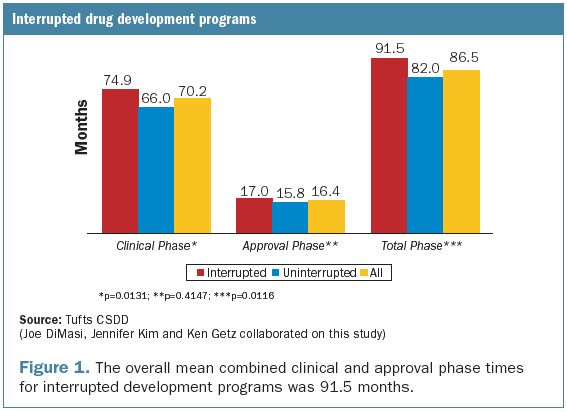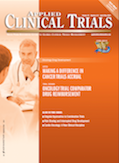Coming to Terms with Interrupted Drug Development Programs
Applied Clinical Trials
Half of all drugs in clinical testing are interrupted by in-licensing, co-development, joint venture and M&A arrangements – and they are taking significantly more time to develop.
Drug development has always been a risky proposition. High failure rates combined with requirements for large and rising development investments have compelled major sponsors to pursue a variety of approaches to share innovation risk through collaboration, including joint development arrangements, in-licensing deals and mergers and acquisitions. Since 2008, sponsors have demonstrated a keen interest in establishing precompetitive alliances and five of the top 10 largest pharmaceutical companies have acquired and absorbed at least one major biopharmaceutical company (e.g., Genentech, Genzyme, Schering-Plough, Wyeth).

M&A strategies represent the most extensive and costly collaborative approach, as fixed infrastructure, capabilities and the portfolio of intellectual property are transferred to the acquirer. In-licensing strategies represent a less extensive shared-risk approach because the licensor has incurred a partial development investment to advance a new molecular or biologic entity (e.g., the investment of capital and resources) before transferring the remaining development risk to the licensee. Co-development arrangements represent the most egalitarian arrangement as both parties share equally in the development risk.
Although the impact of risk-sharing collaborations on success rates and spending has been assessed, until recently, the impact of these collaborations and the interruptions on drug development efficiency (e.g., development cycle time and regulatory review time) that they trigger has not been evaluated. This column shares the results of a recent analysis conducted by the Tufts Center for the Study of Drug Development (Tufts CSDD) and offers insight into an underlying challenge that sponsor companies face in establishing risk-sharing collaborations. Invariably, these collaborations are not yielding improvements in efficiency and speed, begging the question, "What can be done to drive better outcomes from risk-sharing partnerships?"
Setting up the analysis
This study compared development cycle and regulatory approval times of drugs developed by a single firm compared with those of drugs whose development had been interrupted by a collaborative or shared development arrangement. Regulatory approval histories—between 2000 and 2011—for 303 new molecular and biologic entities approved for marketing in the United States by the Food and Drug Administration (FDA) were analyzed. Clinical phase lengths were defined as the time from first human testing to new drug application (NDA) or biologics license application (BLA) submission.
Tufts CSDD added a benchmarked adjustment factor to the total clinical phase length for drugs that had prior foreign testing before their investigative new drug (IND) filing. Approval phase was defined as the time from NDA/BLA submission to NDA/BLA approval. Total time is defined as the sum of the time from first human testing to NDA/BLA approval for marketing.
To determine the type of risk-sharing arrangement established for each development program, Tufts CSDD reviewed publicly available drug pipeline databases and company-specific annual reports. A single firm included sponsor companies that developed a compound under its sole direction prior to its original regulatory submission for marketing approval. Risk-sharing collaborations included those compounds that were developed at least in part by a joint venture formed to develop the compound; those drugs for which a significant merger or acquisition occurred during their clinical development; those compounds being co-developed where either the sponsor or the other developer originated the compound; and those drugs that were licensed-in to a given company's portfolio during the clinical development period. Detailed development histories were compiled to categorize 289 of the 303 compounds.
Frequency and impact of interrupted programs
Approximately half of all approved drugs between 2000 and 2011 had their clinical development activity interrupted by a licensing, co-development and joint venture arrangement, or by a merger or acquisition for which the originating company was absorbed by a larger firm. In-licensing was the most common collaborative approach, accounting for more than half (54%) of all interrupted programs. One-third of those programs were co-development arrangements.
Tufts CSDD observed variation by therapeutic area. Analgesics/anesthetics, anti-infectives, central nervous system, gastrointestinal, and respiratory drugs had an incidence of interrupted development that exceeded 50%; AIDS, antiviral, antineoplastic, cardiovascular, endocrine, and immunologics were below 50%. Drugs targeting popular illnesses such as CNS and respiratory had particularly high incidences of interrupted programs at 65% and 60%, respectively. Antivirals had the lowest incidence with only one-in-four approved drugs experiencing a development interruption.
Programs that experienced an interruption during development due to a risk-sharing arrangement had significantly longer mean clinical phase duration (74.9 months) compared with that of uninterrupted development programs (66.0 months)—a nine-month longer phase length—significantly different at the p<.05 level. The mean approval phase for interrupted development programs was 1.2 months longer than that of uninterrupted development programs. This difference was not statistically significant.

The overall mean combined clinical and approval phase times for interrupted programs was 91.5 months—9.5 months longer than those programs that were not interrupted. This difference was statistically significant at the p<.05 level. Although clinical, regulatory and overall phase lengths for individual shared-risk collaborative approaches impacted clinical and approval phase lengths differently, none of these differences, compared with those of uninterrupted development programs, were statistically significant.
An implementation challenge
The results of this study confirm that drug development programs that are interrupted by a licensing, joint venture, co-development arrangement or by an M&A transaction take significantly longer.
The risk profile of interrupted development programs is substantially higher than that of drugs developed by a single firm or for which the development program was otherwise uninterrupted. Uninterrupted development programs have approximately a 10-month speed advantage—from development through regulatory approval—on average, over interrupted development programs.
What factors are contributing to elevated risk and slower speed? The introduction of new collaboration dynamics, resource uncertainty and infrastructure adjustment as a result of M&A, co-development and in-licensing transactions no doubt play a key role. Anecdotal reports from professionals who have participated in these collaborative and shared innovation risk arrangements support this assertion.
The growth of collaborative risk-sharing innovation models will likely accelerate in a drug-development operating environment characterized by scientifically and logistically complex and demanding protocols, low success rates and high R&D investments that are targeting smaller market opportunities.
The results of this recent Tufts CSDD study provide benchmarks for portfolio- and program-level planning and forecasting. The results also highlight the critical need for sponsor organizations to establish new integration mechanisms (e.g., governance structures and integration task forces) and more robust metrics (e.g., relationship effectiveness and quality performance indicators), processes and procedures to measure the ongoing impact of risk-sharing collaborations and to minimize the adverse and unintended consequences of interrupted drug development transactions.
Kenneth A. Getz MBA, is the Director of Sponsored Research at the Tufts CSDD and Chairman of CISCRP, both in Boston, MA, e-mail: [email protected]

Managing Medical Devices in Digital Trials: Q&A With Flo Mowlem of ObvioHealth
April 10th 2024Following a webinar on the use of a medical device in a migraine clinical trial, Mowlem caught up with ACT to discuss her biggest takeaways and what she is currently seeing in the digital trials space.
An Examination of the Use of Patient Recruitment and Retention Tactics for Global Studies
March 18th 2024In light of scant published data from sponsors and contract research organizations on site activation and recruitment challenges following the COVID-19 pandemic, the primary objective of this research is to revisit the results of recruitment and retention tactics in studies conducted in 2012 and 2019.